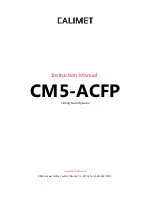
I
I
MPORTANT
MPORTANT
S
S
AFETY
AFETY
I
I
NFORMATION
NFORMATION
I
NTERNAL
E
NTRAPMENT
P
REVENTION
:
This vehicular gate operator is equipped with an inherent (Type A) entrapment sensing device. The system will sense an
obstruction in both the open and close cycles, and will reverse the direction of the gate travel upon encountering an
obstruction. If the system detects a second obstruction before reaching the full open or close limit after the initial reversal, a
warning alarm will activate and the operator will require a reset before resuming normal operation. This is called a “Hard
Shutdown”. Please read and follow the “Shutdown Conditions” section of this manual for more directions.
E
XTERNAL
E
NTRAPMENT
P
REVENTION
:
Non-contact and/or contact sensors must be installed to provide external entrapment prevention in accordance with UL325
section 3.1. Use only UL325 compliant devices and low voltage (24V) devices. Carefully follow the installation manual for the
UL325 device used for installation, usage, and maintenance.
Non-Contact Sensors (Photo Beams):
Non-contact sensors generally are photoelectric cells or like devices. For gate operators utilizing non-contact sensors:
1. Refer to the diagram below for placement of non-contact sensors.
2. Use care to reduce the risk of nuisance tripping, such as when a vehicle trips the sensor while the gate is still moving.
3. One or more non-contact sensors shall be located where a risk of entrapment or obstruction exists, such as the
perimeter reachable by a moving gate or barrier, entrapment areas, and/or pinch points. Use caution when installing
non-contact sensors since some devices only cover a select area. For example, a photo beam will not cover the full
height of a gate/fence area. Refer to the diagram below.
Contact Sensors (Edge Sensors):
Contact sensors generally are sensing edges or like devices. For gate operators utilizing contact sensors:
1. Refer to the diagram below for placement of contact sensors.
2. One or more contact sensors shall be located where the risk of entrapment or obstruction exists, such as the inside and
outside leading edge of the gate. One or more edge sensors shall be located on the bottom edge of the gate if the gate
is more than 6” above ground at any point of its arc or travel.
3. Hardwired contact sensors shall be located and its wiring arranged so the communication between the sensor and the
gate operator is not subject to any mechanical damage.
4. Wireless contact sensors such as ones that transmit radio frequency (RF) signals to the gate operator for entrapment
prevention functions shall be located where the transmission of the signals are not obstructed or impeded by building
structures, landscaping or similar obstructions. All wireless contact sensors shall function under the intended end-use
conditions.
Open beams help protect
areas between the gate and
an adjacent fence or wall.
CAUTION: This beam only
detects at the installed height.
Standard Reverse beams help
prevent the gate from hitting ob-
structions during the close cycle.
CAUTION: This beam only detects
at the installed height.
W
a
ll or
Fe
nce
One or more Edge Sensors shall
be located on the inside and
outside leading edge of the gate.
One or more Edge Sensors shall
be located on the bottom edge of
the gate if the gate is greater than
6” above ground at any point of its
arc or travel.
Bottom Edge
Sensor If Greater
Than 6 Inches
FSW900 Swing Gate Operator
5






































